
Master Shai Hai from Israel, is a 4th dan martial artist specialising in the discipline of Uechi Ryu karate. In this exclusive interview from Japan, Raj at Kung-fu Kingdom was pleasantly surprised at the breadth and depth of Shai’s knowledge and the candour with which he shared an astonishing account of an unforgettable life story.
Here we present an insight into Israeli and Okinawan philosophy, lifestyle and of course, their fighting arts. Let’s join this intensely-poised, humble embodiment of a classically trained, modern-warrior on his journey to Mushin (literally “no mind” or ultimate freedom of expression)!
Raj: Greetings, Shai, thanks for taking some time out to speak with us at KFK! So, first things first, is your name actually Shai-Hai or is that a Japanese given name?
SHAI-HAI: You’re welcome Raj! That’s actually my real birth name! My middle or nickname, is Taru, after my Japanese teacher. It means, someone who is proficient in something. A lot of people in Japan just know me by Taru, and it’s easier for the Japanese to pronounce.
Proficiency…that’s what Kung-fu (Kingdom) is all about… individual accomplishment or skill cultivated through intense, sustained effort and hard work over a period of time… When were you born and what are your stats: height and weight if we may know?
Yes, I was born on the 28th August 1982, I am 181cm (5ft 11in) tall and 79kg (12.5st). It’s good to hear about the definition of kung-fu because you don’t often hear it in the western world. You know, in Okinawa there’s the traditional Okinawa quarter divided into four main quadrants that I can perceive and put my finger on.
Divisions?
Divisions yes. The first one is the self defence and the physical part, the iron body, the part that everyone knows, sees and has heard about. Then there’s the second part which is the control of the mind, which basically controls the body. Developing the mind, keeping it stable with a strong spirit. The third part is about maintaining one’s health, nutrition, the food you eat. Not a lot of people know that, but in traditional karate this is basically the traditional nutrition.
Then we have miso soup after every meal. It helps soothe the stomach and one’s digestion. Green tea, and rice, are the main staples in Okinawan nutrition.
The third part, is a way of living along with exercises, you work out until a late age, eat right and eat correctly. You adjust your nutrition according to your environment and chosen lifestyle. In cold countries it’s acceptable to eat meat every now and then, but in warm countries I would say that meat rots really fast, stays in your stomach and can play havoc with your energy levels.
Fatigue develops…
Yes…So, fish and vegetables are among the secrets for the longevity of the Okinawan people.
Ah interesting, so they don’t eat much red meat I guess?
No, not much! The fourth area, which I have come to believe is the most important I’ve witnessed in Okinawa, is called kizuna. This is a term that refers to social connectivity in society. For instance, the relationships inside and outside of the dojo, with family, with co-workers and the rest of the world.
Master Shai demonstrating form, kata on stage
How fascinating!
The beautiful thing in the Okinawan quarter is you actually see this in action. You get to know all of the great masters and there are quite a lot of them and fortunately, I get to work with a lot of them. They do some kind of charity, you know like Operation Asia.
Sounds ideal…
Inside the dojo they support each other and every dojo has this thing called the moai which literally translates as: meeting for a common purpose. Everyone that participates in the moai gives a certain amount of money and every month that entire amount of money raised goes to one part. It’s like a bank for friends. In those meetings they talk about art, about helping each-other, about pertinent subjects important inside the dojo, and how they can develop themselves.
Almost every Okinawan traditional dojo does that, but it’s not so common in the western world. It’s a pleasure to hear about that spirit of co-operation regarding the martial arts. I do the same thing in my dojos and, all around the world, I try to promote this awareness. So you see, it’s not only about fighting, or self defence; it’s also about what you give to society, to nature, to the world around you! Martial arts is a method of self-development. Helping you to develop your spirit, your mind and your physical being. First of all, you have to be a good, kind person. That is the beginning and end of the martial arts. In other words, you’re never going to be a good martial-artist if you’re not compassionate and broadminded. You can be a fighter maybe, but not a good martial artist. There’s a big difference between the two!
This reminds me of what Sensei Benny The Jet Urquidez said…
Yes…
Yes. I agree 100%!
Now Shai, how many years have you been training, can you tell us at what age you started?
Well, I’m 30 years old now, and started when I was 6, so 24 years. I started in Israel studying Israeli self defence and street fighting. Back then, in Israel where I come from (Tel Aviv) it’s really necessary to know how to defend yourself, there’s no pretence! If it’s not the terrorists, it’s going to be the people on the street who are going to be after you. Some places where we come from are really dangerous, you get hot-blooded people that are really quick to anger! So you may well assume, Krav Maga, the Israeli martial-arts and self defence is really big in Israel!
Pretty much every high school boy takes part in lessons at one stage or another. I took it more seriously, as, when I was six years old some older kids bullied me, tied me to a tree and burned the tree. I was almost about to die until someone found and untied me really quickly. Eventually the school where all this happened came to an agreement with my parents to send me to study self-defence, at their expense.
Right.
So, I started it when I was a kid. I studied there for six years then they opened a kung-fu class which I immediately joined, I did it around the same time as I did the self defence. Then, when I reached age seventeen I knew I wanted to do martial arts for the rest of my life professionally. I travelled to New Hampshire, America to study with the my teacher’s teacher and ended-up staying at his house for seven years.
What this means is, I used to shovel snow in winter time, chop wood, clean his home, look after his baby kid. In return for that, he would teach me.
You know when I first came to him he was rather old, and had retired but he said that he would accept me as a student.
I trained with him daily. We started training at 5.am for a few hours, then he’d go to work and I would do the housework. Then he came back from work around 4.pm then we would keep training until about 10.pm! That’s how it was for a few years…
Sounds ideal…serene!
Anyway after that, he said it’s time for me to move on. He gave me the name of someone who could continue to teach me, Sensei Shinjo Kiyohide. He’s a very famous teacher, you can look him up on YouTube, and also the Discovery Channel. So, I looked him up, bought a ticket and flew over there.
It was kind of a funny story…when I got to the dojo I saw him inside teaching. I introduced myself and said I’ve been training for many years and had travelled all this way because I want to learn with you, I want to be your student!
He took a look at me with all my tattoos and, being an old school teacher. didn’t like me, immediately disagreeing, no! He said, “Look, I don’t accept new students, so go away!” I went back to the hotel, really disappointed. I had already determined that I wasn’t giving-up, so the next morning, I went to his house and waited patiently outside his dojo. He woke up, got out on the porch and saw me sitting nearby. He went downstairs and I approached him with an offering of pineapples and mangoes saying, “I’m begging you, please teach me!”. He again said, No! I’m not going to teach you! If you want, I can maybe introduce you to a different, lower rank teacher…I said, No! I want to study with you, I want you to teach me! He said “No!” and sent me back to the hotel again. Then I said to myself, “I’m not going to give up!”. I went to him several times, knocking on his door. He would wake up in the morning, see me sitting near the dojo and likewise he would go to sleep at night and still see me outside the dojo. Eventually, he acquiesced, and said, “you know what, I’ll give you a try, you’re not much yet, but just come to the dojo in the evening…”
You got your break!
I did! I came in the evening, with my gear and training outfit and he asked me to demonstrate kata (routines) for him. Soon enough I took part in sparring with an Okinawan champion. It was a very hard fight, one of the hardest fights I’d ever had in my life with a very, very strong, tough opponent. I came out the winner in that particular bout… eventually sensei said that he would accept me as a student but that I’d have to start from white belt all over again!
Memories of The Karate Kid come to mind…This is what the old school tales are made of! What was the name of the teacher that you were training with originally?
He was Richard Ragzkoff. An interesting figure in the Israeli martial-arts world. He came from the US and lived in Israel for 20 years in the 60’s He was well-known for his extreme ways of training…he would break the students, be really harsh and tough on them! He was actually a very close friend to the founder of Krav Maga.
So, he and the founder of Krav Maga learned from each other. Richard’s style is basically kung-fu, but not the orthodox kung-fu, it’s mixed with the Israeli styles of self-defence and street fighting. It’s his unique style. This is no bad thing since the number of martial arts probably as vast as the number of teachers in the world!
As to styles…you were trained in the Israeli style of self defence followed by kung-fu then Okinawan martial arts…
Yes, and I’ve been travelling here to Okinawa for the last seven years studying and teaching Uechi Ryu Karate.
Who would you say the most influential martial arts teachers have been for you?
Well at the top of the list is my current teacher is Shinjo Kiyohide, he taught me about budo you know, the entire philosophy of martial arts, the way of life of a martial artist including combat of course! The second one is Richard Ragzkoff my former teacher. I would say the third one is Seiko Toyama. Followed by Tatsuhiko Toguchi…they’re all very dear to me!
What level are you at the moment?
In Shorei ryu karate, 3rd dan, in kung fu I have the rank of sifu and in uechi ryu, 4th dan with jun shihan title.
You mentioned Kumite tournaments, can you tell us more?
Yes part of the Kumite is inside the Dojo.
Is the Kumite still very much an underground affair or is that all public now?
In Okinawa it’s public, but in some parts the United States, it’s still underground!
Is it basically no rules?
Right, no rules. You know it’s not for fame, it’s just for money. When I stayed in America I had to do that because I had to provide for myself, make some money…
Can you give us an idea of the biggest prize that they would give in a Kumite, if you win?
Well that depends, on the chances and the other variables, it’s not huge amounts of money but probably a good eight thousand dollars in a night…
Intriguing! Now let’s move onto one of your specialities. Tell us about the security or bodyguarding work that you do…
Yes I get to work with a lot of interesting people. Two months ago for example I was bodyguarding for very famous artist dubstep producer: Borgore based in Los Angeles. I joined him just nine months ago on his tour as he travelled all over the United States. He was doing a video with Miley Cyrus. I would say he’s one of the most talented and nicest people that I’ve met, Miley’s also a really nice, down-to-earth girl.
SHAI-HAI
It was great to visit so many interesting places, small towns, big towns, while working closely with artists such as Telax, I get to meet personalities like Macie Grey and Ali Golding, a lot of fun!
I remember I also met Jean-Claude Van Damme once in Tel Aviv, my friend introduced us. He came to do a movie or something and they told him, you have to meet this guy Shai Hai, he’s one of the best martial artists in Israel. He came up to my table and we talked and drank together -it was good, he’s genuinely a nice, pleasant guy!
In addition, I also work with a lot of business people who travel to places like Hong Kong or Africa where they need someone to watch their backs. They often don’t feel safe contacting a foreign bodyguard from the destination where they’re at because, it can turn out to be a set up! You can get someone Africa and tell them you need a bodyguard because you’re coming for business and they would be the very ones arranging for you to get kidnapped or robbed!
Pays to have your wits about you! Shai, how many students do you have and whereabouts in the world are they?
Of course! Well, I would say my organisation has about three hundred people. They are in America, yet with most of them in Israel.
Excellent! Do you train weapons Shai?
I’m good with knives, standard and commando knives. There was much training with Sensei Ragzkoff, who was in the Vietnam war and a Green Beret before. He was a real pro with knives. The same techniques can be used with a key, screwdriver, pen and so on, it doesn’t have to be a knife, those other things can prove to be lethal weapons too! I’m good with guns too. I mostly disarm knives and guns.
So you were talking about weapons, you don’t train much with swords but Japan is so well known for Samurai and Ninjas with weapons like shuriken stars and such, do you practice with any of those?
That’s all very true, but I try to keep my training as real as possible. If you don’t walk around with the sword in the street, I would say it’s a waste of time for what I do! If that weapon that is not useful in the street, I generally wouldn’t do it.
Yes, so you’re focussed on the basics, awareness, quickness, reflexes, hands, feet?
Yes exactly!
You have to be creative in that sense don’t you?
Yes you have to be creative, you have to be efficient, you need to know where and when to hit as it’s even connected with the hours of the day…
Hours of the day? You mean in terms of energy…
Energy flow, yes. At certain points of the day some organs are more while others are less active with the energy flowing a certain way. If you know where, when and which direction to hit, it can cause a lot of damage.
Incredible subject matter…
I think it’s very important to know, afterall, martial arts were created so a small person could overcome a big one and there are mountains out there in the street! I’m not a big guy but I have worked as a bouncer, in Japan and in Israel and fought a lot of people. Usually those people, especially in Okinawa, like the marines, they’re huge, double my size. If I relied on my strength and power alone, I would be dead!. Sometimes you have to fight. Sometimes I would have to fight with more than one and it’s really important to finish the fight. The rule is you always finish the fight before it’s even started, if you can help it, don’t even go there, don’t get into a physical fight. But let’s say it happens and you have to protect yourself, it’s really important to finish it as fast and as efficient as you can.
Open hand techniques are what I’m looking for. I wouldn’t hit the face with a closed fist because it can cause damage to my arm and it can cause damage to my hand and may not cause any damage to his face! However, with open hand techniques you can use just the fingers or your hand like a spear. The side of the hand is called shuto in Japanese. So you have the shuto punch, just the thumb or one knuckle fist. You use it to strike toward the eyes or behind the ear.
What about the nose, the nose is still very vulnerable isn’t it?
The nose is vulnerable if you hit with the palm of the hand, not with the fist.
What about groin strikes?
Yes, but it has to be done correctly, I would say that a very important aspect in street fighting is to understand the physiology of antagonism. If you go for the groin his face goes down and toward you, then straight away you hit the chin, that doubles the power of the strike. So you have to have really good timing and you have to know exactly where to hit. But even if talking about the groin, I would still not use a closed fist, I would use my fingers, and thrust upward, for the abdominal area I would use my fingers to grab and tear.
Wo! Sounds painful…
It’s all about strengthening the fingers. We use heavy jars filled with water, we have a lot of exercises designed to strengthen the grip and the fingers.
Once you feel like it’s going toward a fight, the first thing that you have to do is take the position of the begging man, and the begging man position is one of my favourite positions in martial arts. You know you lift the hands up out of sight, close the legs a little bit and then you’re ready for a fight. The opponent doesn’t know that you’re about to fight but you’re up and your hands are easily able to protect your face or upper body. So, while you’re very close to his body, close to his face, you can hit him without him even knowing you can hit instantly!
Right!
The begging man position it’s not only a position, it’s a state of mind. You have to look at your opponent and observe how he is standing, you have to notice how he is breathing and when he inhales and exhales. When he exhales it’s not a good time to hit the stomach.
Protected…
Right. So you talk to him and when he inhales, takes a breath you hit the stomach, his solar plexus and it’s much more powerful. This automatically brings the face toward you, and you’re ready, knowing that movement’s going to happen then you use your elbow to strike his temple or his jaw. It only takes for example, eighteen kilos of pressure to the posture of how most people stand, to break the knee.
That’s physics…
Yes, then, he won’t be doing much fighting…
How revealing…!
Remember this is all for only if you got into a fight. It’s really important not to get into a fight. I think the highest level is to master the art of fighting without fighting…of knowing how not to get into a fight in the first place! But on that occasion where you need to take care of yourself, if you have to fight then you need to know the most effective, hardest hitting way…
Shai Hai Sensei- Israeli Street Self Defence
Now onto a lighter subject: martial arts movies. Which would you say you’ve been influenced by?
I’ll be honest with you, I’ve scarcely ever watched a martial arts movie.
Really?
I don’t have a TV in my house, I never did have. Martial arts is pretty much all I’ve known since I was six. I’ve been practicing it, but I never saw movies or anything about it.
That’s pretty incredible, I don’t think we’ve ever met or spoken to a martial artist who has never seen, for example, Bruce Lee in Enter the Dragon or Jackie Chan in Drunken Master!
Most would think I would have done because it’s part of my world, but I’ve never gotten around to watching TV, especially those kinds of movies. If I would watch TV, it would probably be National Geographic or something…
Unique…! Shai, may we know what new projects you’re involved with right now?
Apart from teaching in America, Japan and Israel and security assignments, I’m collaborating with an organisation called Budo for Peace. It teaches to use Budo in the martial arts to bring together people from different countries and religions.
It does aim to deal with conflict like those in the Middle East between the Arabs and the Jews. You know, like we say karate is for everyone. If you want to study, you are my brother and it doesn’t matter if you are Arab or Jewish or American or whatever… So it’s really about teaching the martial way, including mind control, how to become strong, not only physically but mentally too.
We have an upcoming teaching tour in Australia very soon now!
Sounds great! Now let’s talk about training Shai. How often do you train, I know you said that you do a lot of classes and so on, how often do you actually train yourself?
Well you know like I try to spend as much time as I can in the main Dojo in Okinawa, you know just as a student to study with my teacher, but you know this is the reality I have to be a teacher and I have to teach too. It can be really hard if you’re a teacher and you have to take care of the students the dojo and all the administrative duties. You know some days it seems like you don’t have any more energy left, that can be more tiring than fighting! I like to train at least two hours per day, every day. Sometimes, I would workout in the morning and sometimes doing it after class at night. I train the physical basics like push ups, pull ups, traditional exercises such as lifting heavy jars and Chishi, which is a piece of wood with a stone weighing anywhere between 5-15kg at the end of it. It’s the equivalent of Okinawan weight training. I also do iron body katas, isometric and isotonic exercises, sanchin (stretching and flexing of the body’s tendons) and spar with some of my top students every day doing the conditioning exercises together.
Ever since I started there wasn’t a day that I missed training. Even if I’m sick and ill and have a high fever, I always go to the dojo and train. I tell myself, “it’s either me or the germs, someone will die today!” I’m still here so I guess something’s worked out!
The ‘burn your bridges’ approach…
Quite!
What would you say is the most ambitious, dangerous or daring stunt that you’ve ever done?
Oh wow we’ve been doing quite a lot in demonstrations, breaking concrete boards, concrete bricks and breaking bottles. We’ve been breaking four by fours on our trapezoid area, our hands like our forearms legs, breaking four by fours, but I would say like breaking baseball bats with our forearms. I would say that the hardest thing that I’ve done is breaking four-inch, solid wooden pine boards, with my fingertips.
I’ve been doing a lot of TV in Israel you know a lot of The Sports Channel and The Men’s Channel and The Fighting Channel they all have profiles, like stories about me and sometimes they come and they want me to like demonstrate the finger tips breaking. Sometimes, it’s really not easy but you just have to keep really fit and strong all the time.
Those are impressive feats! What about injuries?
Yes I broke my fingers and toes a few times, and my leg from kicking. We’re kicking with the toes, you train for years and years and accidents happen sometimes you know!
So how do you get around the healing process of that for example, if you break your toes how do you train around that?
Usually I use acupuncture needles on myself to bring the energy there so it can heal faster. I use something that’s called Yunanbayou, and when I’m in Hong Kong or China I buy it, it’s really good, you spray it on the wounded area and it helps a great deal -a wonder actually! Usually within a couple of weeks everything is back to normal. I also make my own medicine. Mix Japanese knotweed with Awamori (Okinawan version of Sake) raw egg and vinegar. Then rub it on the pain putting nylon on it before going to sleep…you wake up in the morning renewed!
Wo! I’m intrigued and relieved to hear of homeopathic remedies like that! Could you share some training tips that have worked well for you, that you would recommend to someone doing martial arts or any intense physical training?
Well first of all you have to eat very well and you have to sleep very well. It could be six and a half hours a night, maybe seven. You have to know your body, and you have to know what you can and can’t do.
Yes.
Concentrate on the things that you know and do it and then concentrate more on the things that you don’t like and train those twice as hard. It can be frustrating sometimes, but if you can control those things and make them better, even the good things that are already in your technique will be a lot better.
Solid advice! You mentioned earlier at the beginning something about food, do you keep a special kind of diet which is useful for you?
Definitely!
In Okinawa there is a system of nutrition called Magowayasashii, which breaks down as Ma (mame =beans or soy), go (goma =sesame) wa (wakame =seaweed), ya (yasai =vegetables) sa (sakana =fish), shi, (shitake =mushrooms) i (imo =sweet potato or oats).
My diet consists mainly of fish, seaweed, soy (tofu) beans, potatoes and a lot of fresh vegetables. I also eat rice (a better energy source than bread) and some eggs, but I don’t drink milk at all.
Bitter melon is, I think, the healthiest vegetable that I’ve came across -it’s got so many good things in it that I would definitely recommend anyone to try it. It’s an acquired taste because it’s bitter, but once you get familiar to its taste. it gets really tasty and all the more so because it’s healthy, doing you good!
How does a day in the life of Shai Hai shape up?
Basically, I wake up early in the morning about 6am, make myself a good salad, stretch-out and go for a 30 minute run, just to get the body going. Then I get home, take a shower and start my day!
Excellent…now the motor’s running…!
Yes! Then, usually I go to the dojo and train my private students. I have morning and evening sessions. It’s one student after another then I break an hour for lunch, go home, see my wife and son. Then back to the dojo for group training. We have both kids’ classes and adults’ classes. .
Then afterwards, I usually train myself before I return home. Practically every night it’s the same going out with friends for a little drink and sushi. It’s really important to me that every night finishes with my students, we are like family. My students, my wife and I sit somewhere in a restaurant or social place and we eat, talk about the day, laugh and have fun. Then I go to sleep. If I don’t do this it’s like I don’t feel the day has ended!
Sounds special! So you like to have a review and celebrate the day… Wonderful! Do you have any other hobbies that you do to relax?
Yes. I play the Sansai (Okinawan guitar) which I studied for many years in Japan. I like playing music, sometimes I make clay sculptures.
Do you have a favourite martial arts book? What do you think of Miyamoto Musashi’s The Book of Five Rings (Go Rin No Sho), for example?
I’ve read that yes, it’s one of my favourite books. Another one of my favourites is The Hagakura (The Way Of The Hidden Leaves). A samurai himself called Yamamoto Tseunetomo wrote it so it’s really priceless! It’s the oldest book about the Samurai…
Now on reflection Shai…What would you say has been your proudest achievement to date?
I would say: my senior students: I see them work and I see them teach. Just the fact I would sometimes be in my dojo participating in the classes just like every other student and letting my senior students teach. It’s just amazing to see like how good and how developed as martial artists they’ve become. This makes me most proud.
What would you say you are most grateful for in life?
I’m grateful for finding the martial arts and the Buddha way. If I take into account where I grew up and my character, I know that without the martial arts, I could be in jail or in the grave!
That’s a very humbling gratitude check…
I’m really really thankful for finding the martial arts and finding this way. It influences pretty much every area of my life. I don’t know anything else that fills me up with such love…it’s the only thing I know…I don’t really know myself without martial arts! If you would take it away from me today then I guess I wouldn’t know what to do! I’ve been doing it for so long and there’s something definite inside of me that wants to grow. I want to support the people around me as well as my students. I want to spread this great art so it can help as much and as many people as it can globally, encouraging them to be better people, which includes respecting the environment too!
What advice would you give someone who is looking to start in the martial arts what should he or she should look for?
That’s a good question! It all depends what you want for yourself, so realise that first, whether you want to do it as a hobby or seriously want to get into it. I would say find a good place where you can feel comfortable with the teacher, the environment and the people inside the dojo. It has to be something that you can persist with for a long time so don’t choose a dojo that is difficult to reach because that’s another obstacle that could turn into a reason to quit. It also has to be something that you can personally relate to, as not all martial arts are the same! There are soft styles, hard styles, with and without contact. You have to define what you want, then you can find the right place for you…
What message would Shai like to share with Kung-fu Kingdom readers right now as well as with those who follow your work around the world?
Simply that we are all one and we are all brothers and sisters and it doesn’t matter where you come from or your race. Just developing a really nice inner-heart and spirit, that is the message of the martial arts.
Timeless wisdom! How would people wanting to find out more about you, your style, perhaps joining-in your classes, get in touch with you, what’s the best way?
They are welcome to visit my website http://shai-hai.com/ go to contacts and send me an email from there!
Great! Well Shai, just like to say this has been a fascinating interview we really appreciate sharing the breadth and depth of your martial knowledge and warrior wisdom with a distinctively Japanese/Okinawan angle!
My pleasure! I think we’ve been discussing for quite a while, but it seems like just minutes!
Hopefully next time I talk to you, I’ll know more Japanese, but for now arigatou! Keep in touch!
Thank you very much, Raj, talk to you soon!
Shai Hai’s Master, Shinjo Kiyohide’s breaking demo:



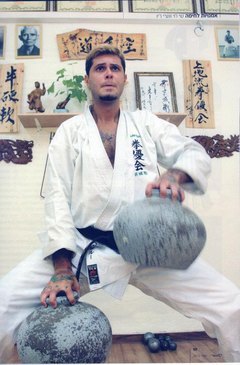

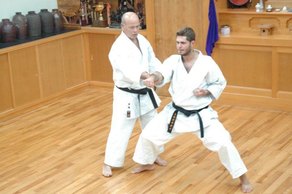
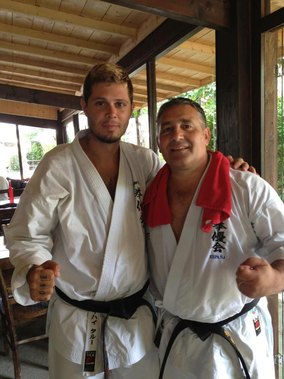

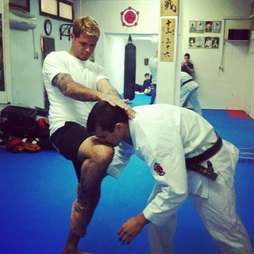


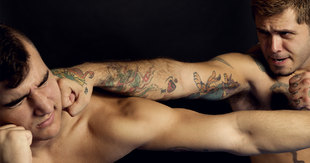



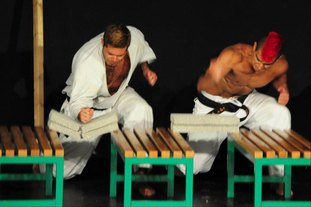

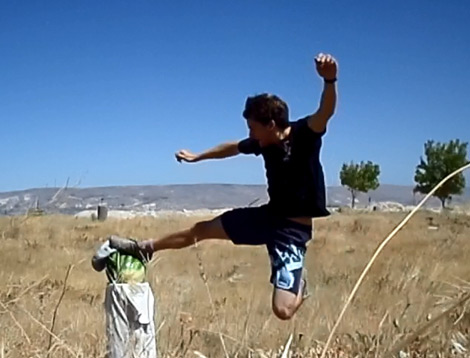

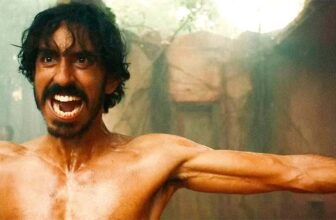


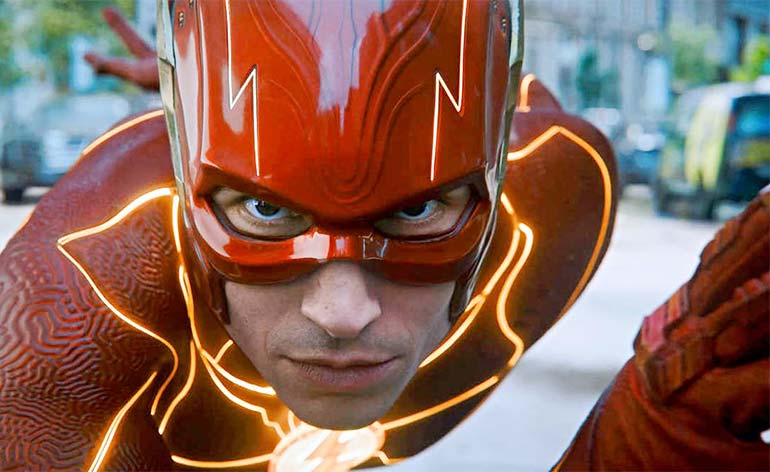
An amazing and inspiring story of a man truly dedicated to martial arts, always ready and eager to continue learning! Ossu!
Shai Hai rocks! I am his biggest fan…
This is a favorable and thought-provoking interview, the way of martial arts appears as a journey from outer to
inner, from taking care of the body, body-control, to subtle mind and even beyond… Master Shai’s
insights here are wonderfully moving and authentic.